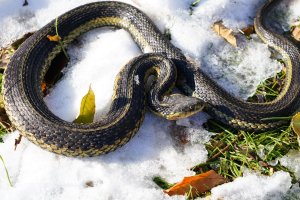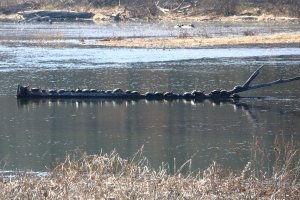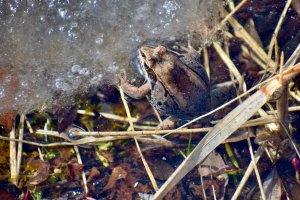Where Did All the Snakes Go?
January 11, 2023
By: Samantha Volz – Park Interpreter
Winter adaptations: reptiles and amphibians
 Many of us have long forgotten the reptiles and amphibians of summer but believe it or not, winter is a perfect time of year to discuss our “cold-blooded” animals. Michigan is home to over 50 species of reptiles and amphibians including snakes, turtles, salamanders, lizards, and frogs. Reptiles and amphibians are “cold-blooded” or ectotherms, meaning they regulate their body temperatures through external sources. Unlike humans, who are endotherms, and can regulate their bodies through internal processes. During winter in Michigan, we can expect heavy snowfall and below freezing temperatures which make for extreme conditions to live in. How is it that animals who regulate through external means can survive such a harsh environment?
Many of us have long forgotten the reptiles and amphibians of summer but believe it or not, winter is a perfect time of year to discuss our “cold-blooded” animals. Michigan is home to over 50 species of reptiles and amphibians including snakes, turtles, salamanders, lizards, and frogs. Reptiles and amphibians are “cold-blooded” or ectotherms, meaning they regulate their body temperatures through external sources. Unlike humans, who are endotherms, and can regulate their bodies through internal processes. During winter in Michigan, we can expect heavy snowfall and below freezing temperatures which make for extreme conditions to live in. How is it that animals who regulate through external means can survive such a harsh environment?
Reptiles and amphibians possess several behavioral and physical adaptations that allow them to survive even the coldest of Michigan’s winters. Michigan mammals such as the groundhog survive the winter by entering a period of dormancy, called hibernation. Reptiles and amphibians also will use this adaptation strategy, but it is instead referred to as brumation. During this period of dormancy, reptiles and amphibians will slow down their internal body processes including their heart rate, breathing and metabolism. These animals will go weeks or months without food or water, living off stored fat in the body. This does not mean that they are completely inactive throughout the winter. On warm sunny days reptiles, such as the garter snake, can be seen basking in the snow taking advantage of the rare, pleasant conditions.
Many reptiles and amphibians must first find a location, or a hibernaculum, to safely enter brumation. These hibernacula must be deep enough to avoid freezing and flooding. Some reptiles and amphibians will dig their own den or burrow for the winter, but some will take over old crawfish tunnels or rodent burrows instead. Garter snakes are known to overwinter in dens with hundreds, if not thousands of other snakes and will emerge in huge masses early spring.
 Aquatic ectotherms, such as the painted turtle take a different approach to winter survival. Overwintering turtles will often bury themselves down in the mucky bottom of ponds, deep enough to where they will not freeze. Once the water freezes over, not only are the frigid waters an obstacle to overcome but so is the lack of available oxygen. Painted turtles typically will surface about every 30 minutes to take a breath, but with ice coverage this is not possible. Instead to make use of the available oxygen in the water, painted turtles will use cloacal respiration. A turtle’s cloaca is the opening near the base of the tail used for digestion and reproduction and is highly vascular. Using their cloaca, they can absorb dissolved oxygen in the water around them, resulting in painted turtles only needed to resurface for air once every month or so. To quote Olaf from Frozen yes, “turtles can breathe through their butts”!
Aquatic ectotherms, such as the painted turtle take a different approach to winter survival. Overwintering turtles will often bury themselves down in the mucky bottom of ponds, deep enough to where they will not freeze. Once the water freezes over, not only are the frigid waters an obstacle to overcome but so is the lack of available oxygen. Painted turtles typically will surface about every 30 minutes to take a breath, but with ice coverage this is not possible. Instead to make use of the available oxygen in the water, painted turtles will use cloacal respiration. A turtle’s cloaca is the opening near the base of the tail used for digestion and reproduction and is highly vascular. Using their cloaca, they can absorb dissolved oxygen in the water around them, resulting in painted turtles only needed to resurface for air once every month or so. To quote Olaf from Frozen yes, “turtles can breathe through their butts”!
One of the most mind-boggling winter adaptations is that of the Wood Frog. Wood frogs are the only one of the only amphibian species that can be found in the Arctic Circle. While most ectotherms tend to avoid freezing, the wood frog instead will embrace the freeze. These incredible frogs will bury themselves under a thin leaf litter layer each fall. Once the freezing temperatures hit, ice will begin to form around their organs and extremities. Wood frogs will then enter a state of suspended animation where they do not move, breath, and even their heart stops beating. How can they do all this and still live to see another day? Wood frogs can pump their body full of glucose (sugar), and urine which prevents lethal damage to the internal organ structures and cells from drying out. Wood frogs can have over 60% of the water in their body completely frozen, and yet once spring rolls in they will “thaw” and life begins again.
 Winter can be harsh and unforgiving, but due to some amazing adaptations, our reptiles and amphibians are able to come out the other side to enjoy the coming spring.
Winter can be harsh and unforgiving, but due to some amazing adaptations, our reptiles and amphibians are able to come out the other side to enjoy the coming spring.
